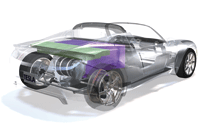
Reinventing the Automobile: What it takes to make a clean machine
Our continuing love affair with sleek, buffed high-performance cars and our dependence on motorized transport are presenting society with a huge dilemma. The earth’s ecological systems are rapidly degrading and motor transport has played a part in this. The wheeze of gas-guzzling vehicles and the choke of urban smog are powerful reminders that if we are to continue to enjoy the convenience, comfort and advantages of personal mobility, clean energy vehicles are a “must.”
Transport, and the mobility it affords, drives development, opening doors to education, employment, healthcare and many other life-enhancing activities. That said, transport is currently responsible for 23 percent of global, energy-related greenhouse gas emissions of which 74 percent is attributable to road transport. Although only 13 percent of the world’s population own vehicles, the global fleet already numbers an estimated 900 million and is set to triple by 2050 with the strongest growth in developing countries. With the rise in vehicle ownership, meager progress has been made in reducing overall vehicle emissions in spite of gains in improving fuel efficiency and lowering tailpipe emissions.
These factors, in addition to dwindling energy reserves, highly volatile energy markets, rising environmental consciousness and growing demand for eco-friendly cars are fuelling the “green” imperative within the auto industry causing it to shift into a new gear. The race is on to develop the ultimate eco-friendly vehicle that is affordable and cost-effective to run. The relentless stream of new models launched by automakers across the globe, from Tata Motor’s Nano – billed as the world’s cheapest car – to BYD Auto’s (China) plug-in hybrid (PHEV) sedan unveiled in late 2008, said to be the world’s first mass-produced PHEV, attests to the dynamism with which the industry is taking up this challenge.
The search for alternative fuel-efficient, low-emitting and energy-diverse “powertrain” systems has already given rise to hybrids and is fostering innovations in battery production, electronics and materials engineering, paving the way for the next generation of green vehicles.
Innovate or die
The business of making vehicles is capital intensive, requiring massive up-front investment to develop products that have a limited lifespan. It is an industry characterized by rapid technological advances driven by ever-evolving consumer tastes and an increasingly stringent regulatory environment. Innovation is a constant within this industry, shaping every aspect of the business from the know-how required to craft and improve efficiencies in vehicle manufacture to the creative expertise needed in applying and marketing auto technologies for commercial success. The intellectual property system plays an extremely important role, in protecting core technologies, designs and knowledge assets, and in underpinning the strategic alliances that characterize the industry as well as automakers’ ability to promote, develop and capitalize on the strength of their brands.
Automakers are jostling for pole position to produce and commercialize an affordable, high-performance zero-emission car. The fact that the industry accounts for around 17 percent of global research and development (R&D) expenditure, reflects the importance of innovation to auto companies that are seeking to beat off the competition, respond to evolving consumer tastes, gain distinction and secure market share.
The US Environmental Protection Agency estimates that fossil-fuel automobiles emit 1.5 billion tons of greenhouse gases into the atmosphere each year. Parked end to end, one million cars would circle the planet 125 times!
Hybrids – a transition technology
The drive to identify and use alternative and cleaner energy influences the conceptualization, design and engineering of vehicles, with greater emphasis on electronics than mechanics. The availability of hybrids that run on a combination of fuel sources – typically gas and electricity – signals a transition, bringing us one step closer to containing the environmental impact of motor transport and to the mass production of clean energy vehicles.
The move toward electric propulsion is a paradigm shift in the auto industry. Performance, range and price have been the main challenges in developing electric cars but advances in battery chemistry – batteries are a critical enabling technology for electric and fuel-cell cars – mean we are inching towards solutions that offer improved energy storage, reliability and safety.
Energy can be carried on-board vehicles as liquid fuels, electricity or hydrogen or a combination of these. Each variation poses enormous design, engineering and technological challenges.
| Hybrid vehicles |
|---|
|
Hybrids combine two power sources, generally an internal combustion engine and an electric motor. They offer increased fuel efficiency and lower emissions along with performance levels comparable to petrol-fuelled vehicles. According to Toyota Motor Corp, the Prius hybrid produces 55 percent less carbon dioxide (CO2) and nearly half the nitrogen oxide (NO) and hydrocarbons of equivalent petrol-fuelled models. Industry forecasts suggest that by 2011, 11 percent of all cars will be hybrid. This versatile technology can be used with a range of combustion engines and in various combinations, from “micro” hybrids (limited to recovering braking energy) to “plug-in hybrid electric vehicles” (PHEV) – when the battery is low, an internal combustion engine takes over. |
While all major automakers are now embracing hybrids, Toyota pioneered the technology, launching its first hybrid, the aptly named Prius (meaning “to go before” in Latin), back in 1997. In the current second-generation Prius, the drivetrain alone is covered by 370 patents – an indication of the technological hurdles the company had to jump in developing the car. The third-generation model, said to be one of the world’s most aerodynamically efficient cars (equipped with solar panels, pointing perhaps to another trend in using renewable energy sources for vehicles) resulted in the filing of over 1,000 patents worldwide.
How eco-friendly is electricity?

The Model S electric sedan, recently launched by California-based Tesla Motors and due to go into production in 2011, can travel up to 300 miles (482.7 km) on one charge. With a top speed of 130 mph (210 km/h), the car goes from 0 to 60 mph (96 km/h) in around 6 seconds and at US$49,000 is billed as “the first mass-market highway-ready electric vehicle” by company Chief Executive Officer, Elon Musk. (Photo: Tesla Motors)
Dollars per mile, electric cars are cheaper and more eco-friendly. But while electric cars have zero tailpipe emissions, their ecological impact depends on how the electricity that fuels them is produced. For example, a vehicle consuming 15 kilowatt hours (kWh) per 100 km in a country where the electricity production generates 800 grams (g) of CO2 per kWh has a well-to-wheels CO2 balance of 120g/km (the European target for all new cars by 2015). In countries where electricity production is cleaner this balance falls, for example, in Germany to 75g/km, in France to 15g/km and in Sweden to under 10g/km.1 These balances compare favorably with the longer-term European target of 95g/km for the new car fleet by 2020.
There are, however, many pathways to generating electricity, and electric drive technologies will enable motorists to tap into a diversity of energy sources. We must, however, be wary of trading one problem for another when identifying and developing alternatives.
Batteries: Re-charging the future
Experts generally agree that the lighter weight, power dense, rechargeable, lithium-ion cells will power future generations of cars. These energy storage devices have lower toxicity levels than the lead acid and nickel metal hydride batteries used respectively in conventional and hybrid vehicles.
The global market for lithium-ion batteries is forecast to be worth US$2 billion by 2013. This prospect is spurring the formation of innovation alliances across the industry and beyond. Examples include:
- the “Lithium Ion Battery ION 2015” initiative where BASF, Bosch, Evonik and Volkswagen have joined forces, pumping €360 million into lithium-ion battery R&D;
- the U.S. Council for Automotive Research (USCAR), a partnership between the U.S. Department of Energy, Chrysler, Ford and General Motors (GM) which researches advanced energy systems offering electric cars increased range and performance; and
- Panasonic EV Energy Co., Ltd., a joint venture between Toyota and electronics specialist Panasonic Corporation to develop and manufacture batteries for hybrids.
German auto giant Daimler AG alone currently holds 25 patents in lithium-ion battery technologies. According to Bob Lutz, Vice-chair of Global Product Development at GM, “Breakthrough battery technology will drive future automotive propulsion, and the company that aligns with the best strategic partners will win.”
Alternative fuels
The growing availability of biofuels is also helping to reduce emissions and dependence on petroleum. Mixes such as E85 – 85 percent ethanol and 15 percent petrol – are enabling the industry to improve environmental performance while continuing to leverage investment in gasoline engine technology. According to GM, there is enough feedstock for the production of ethanol in the U.S. to offset nearly 40 percent of the energy requirements for automobiles up to 2030. The cellulosic ethanol used in E85 fuels is derived from agricultural (the cornstalk itself), forestry and municipal waste.
Hydrogen, the most abundant element in the universe, offers a promising fuel alternative and hydrogen fuel cells, which have powered space flight for decades, are on the brink of becoming the next core power generator. These fuel cells are environmentally benign, converting hydrogen into electricity via an electrochemical reaction, the by-products of which are water and heat. The prohibitive cost of producing and manufacturing fuel cells, however, has thus far prevented more widespread adoption and use of the technology. But major technological breakthroughs in power density, cold-start capability, system efficiency, durability and production costs mean the industry is coming ever closer to a commercially viable solution.
Cars may also be fuelled by liquid or compressed hydrogen using conventional engines but issues of storage, containment, delivery and safety all need to be addressed before hydrogen fuel stations become commonplace in the consumer market.
The clean machine: an enduring promise
Many automakers are now injecting eco-principles into the lifecycle of car production from conception to disposal. The expressed goal of Nissan Motor Co., Ltd., for example, is to have a 100 percent recovery rate for each car produced. The new Renault Laguna comprises 35kg of recycled plastic that make up over 100 eco-designed components. Over its lifecycle, the Laguna eco2 TM generates 3 tonnes less CO2 than its predecessor.
Innovation has been a hallmark of the auto industry since the first car was built. In the 130 years since Karl Benz, pioneering founder of Mercedes-Benz, received the patent for his first engine in 1879 (German Patent DRP No. 37435), countless innovations have progressively improved the efficiency, comfort, safety and performance of motorized transport.
The need of the hour is revolutionary innovation in energy technology, both within the auto industry and beyond. The specter of rising urban congestion and the need to stem emissions leave no doubt that the vehicles of the future will be, by necessity, “green.” The environmental imperative is transforming the DNA of motor vehicles, fuelling a trend that promises to make clean motorized transport a realistic option in the very near future.
By Cathy Jewell, WIPO, Media Relations and Public Affairs Section
_____________________
1. Pierre Varenne, Director, Michelin Research Center, Fribourg, Switzerland, cited in the Motor Show Magazine 2009
The WIPO Magazine is intended to help broaden public understanding of intellectual property and of WIPO’s work, and is not an official document of WIPO. The designations employed and the presentation of material throughout this publication do not imply the expression of any opinion whatsoever on the part of WIPO concerning the legal status of any country, territory or area or of its authorities, or concerning the delimitation of its frontiers or boundaries. This publication is not intended to reflect the views of the Member States or the WIPO Secretariat. The mention of specific companies or products of manufacturers does not imply that they are endorsed or recommended by WIPO in preference to others of a similar nature that are not mentioned.
